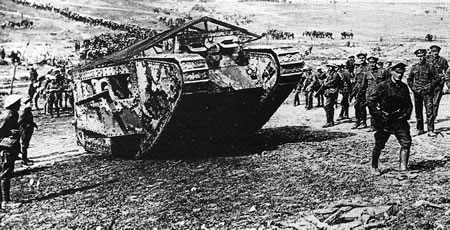The new Heavy Section tank unit moved to France in August 1916, following the British General Staff’s command that they needed the new vehicles in use as soon as possible because of disastrous losses during the Somme offensive the previous month.
A second attack began on September 15th 1916 with C and D Companies’ thirty six tanks. There were meant to be sixty tanks, but failures in construction and engineering meant that only forty-nine were ready on time and a further thirteen didn’t make it to the start of the battle on time due to various mechanical problems.
The first ever tank offensive was not the success everyone had hoped for. The tank crews were still green at best, many had not even completed their training so they barely knew what they were doing, which made traversing the difficult terrain, under attack from artillery, a lot harder than it should have been. A few of the tanks were destroyed almost right away by enemy shelling, while others had to be left behind because they broke down within a short time. However, it was felt that the few tanks that did survive displayed a prowess in battle hitherto unseen, which fully justified their use and the faith of their designers.
 Notable successes during this renewed attack included three tanks overrunning a machinegun emplacement in the village of Flers, causing the German soldiers posted there to flee in panic. One of these three tanks carried on to the next village, Guedecourt, and attacked German troops there. In a separate incident a C Company tank, Crème de Menthe, supported British infantry in a successful raid on a German-occupied factory.
Notable successes during this renewed attack included three tanks overrunning a machinegun emplacement in the village of Flers, causing the German soldiers posted there to flee in panic. One of these three tanks carried on to the next village, Guedecourt, and attacked German troops there. In a separate incident a C Company tank, Crème de Menthe, supported British infantry in a successful raid on a German-occupied factory.
Fighting conditions inside all World War One tanks were extremely harsh. The crew was under threat from choking on exhaust fumes, smoke and cordite from their own guns. The armor plating was extremely thin, often allowing enemy bullets to penetrate as molten lead that would fly around the cabin as ‘splash’. To try and alleviate some of these drawbacks, the crew was issued with masks made from leather and chainmail, but conditions inside were so hot that it was never considered worth it to wear them. The same was true of the leather helmets that the crew were given to protect their heads when hitting the roof of the tank, which they often did due to the lack of suspension. Apart from being uncomfortable to wear in the heat of the cabin, the helmets had a more lethal drawback in that they looked similar to the helmets German troops wore, which meant British tank crews often came under attack by allied fire when they abandoned their machines. This was all assuming that you managed to escape the burning wreck in the first place, something that was made rather difficult by a lack of accessible escape hatches. Also, because the fuel system was assisted by gravity the fuel tanks were high up on these early tanks, making them easy targets, which meant burning wrecks were common.
The first Mark I Tanks were in use here and there, in small numbers, during the weeks following the renewed attack of the Somme and took part in a successful attack on the fortified village of Beaumont-Hamel in November of 1916. Tanks were not used again for the rest of that year, but tank factories were erected during the winter of 16/17 with a tank headquarters in France. During this period, drivers reported that the tanks were easier to handle without the rear wheels trailing behind, so no more tanks were made with this feature